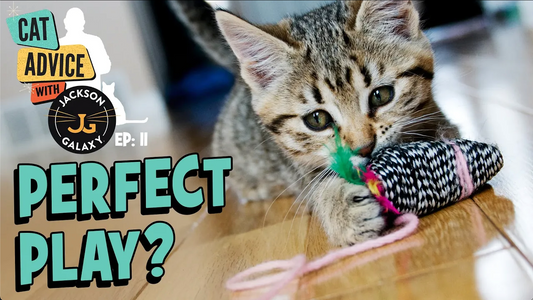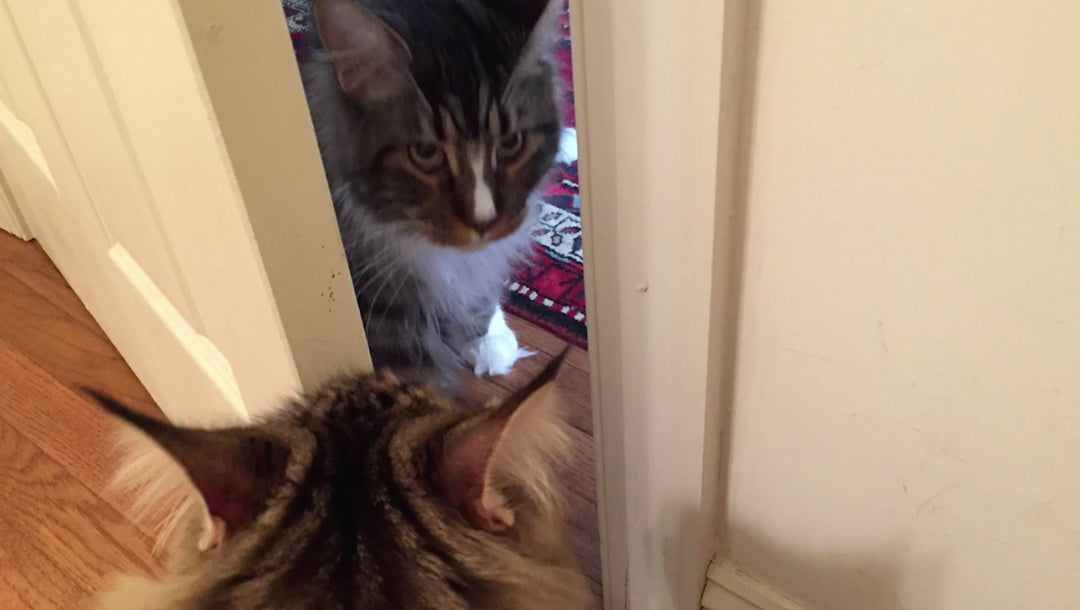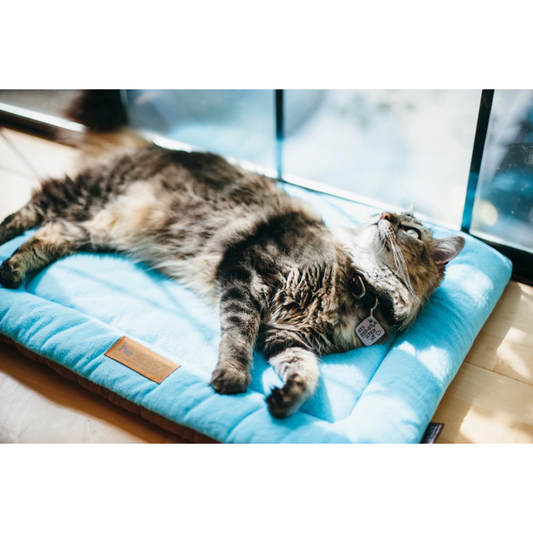As we all know, cats are intensely territorial beings. And yet, when the subject of introducing two cats has come up through the years, I would constantly hear people advise, “Just put them in a room together and they’ll work it out.” Does it work sometimes? Sure, but it’s cat Russian Roulette; Just as often, they might work out who loses an eyeball, but they will not magically work out how to be friends.
Instead, bringing a new cat home can trigger the territorial panic switch in your existing cat, and this often means war. So, do yourself and your cats a favor, and follow this time-tested, step-by-step recipe to a T: It will give you your best chance for a smooth integration.
How to Introduce Cats
Before you bring your new cat home, there are some fundamental steps to accomplish that will give you a significant leg up on the process:
A. No free-feeding - Make sure you have switched your existing cat over to a routine of meal feeding, rather than free feeding her. This concept is foundational to my approach, and nowhere is it more important than during the introduction process. Once these scheduled meal times are established, it will set the stage for both your existing cat and your newcomer to experience a shared, ritualistic way of being: they get fed, around the same time, x-number of times per day. (More specifics about this shared meal time in a moment.)
B. Separate Base Camp (and the mandatory isolation phase) - Base camp is a defined area of your home that is the heart of a cat’s territory. So first, decide where you’re going to set up base camp for the new cat, so he feels like this space is essentially all his own. This could be the master or a spare bedroom, an office, or even the bathroom when there is no other option. As long as the human scent is strong, it will help the cat establish a sense of home by calming scents. In addition, here are a few other important elements associated with successful base camp protocol:
- Scent soakers: Because cats are all about scent, make sure that you have plenty of "scent soakers” in their base camp. Scent soakers are soft items that absorb a cat’s scent, and basically say “I live here,” and allow for rubbing, scratching, or lying in. Beds, blankets, carpets, cardboard scratchers, and scratching posts are all excellent scent soakers.
- No Peeking: One of the hallmarks of this integration method is that the new cat and the resident will not initially lay eyes on each other. This is non-negotiable. Ignore this part of the introduction process at your own peril!
- Site swapping: This is where each cat gets to explore the other’s territory without ever laying eyes on each other. This is also an opportunity for key signposts—like cat trees, litter boxes, etc.—to take on a shared scent. This is crucial to the “getting to know you” process with cats, since so much of their communication is based on scent.
Follow this simple process for harmonious site swapping:
1. Carry the newcomer out of his base camp, put him in the bathroom, and shut the door. 2. Allow the resident cat to walk into the newcomer’s base camp, then shut that door. 3. Allow the newcomer to explore the rest of the home. 4. Rinse and repeat. And by the way, your new cat will let you know when he's ready to move out of base camp and explore the other parts of the house. (It could be anywhere from a few hours to a few days.)- The “Other Side of the Door” Feeding Ritual: This feeding ritual, which is all about creating a positive association between the newcomer and the resident cat, has evolved over the years, but by and large has always worked for me. What’s involved? Very simply, mealtime will consist of bowls set up on either side of a closed door. These bowls should start out far enough apart so the cats will walk up, eat, and walk away without incident, but close enough that they sense there’s another cat on the other side of the door. From there, we gradually move the bowls closer.
Here's a video with more info:
Step Two - Visual Access
With both cats now acutely aware of the other’s scent, it’s time to let them actually see each other. The work you’ve done up to this point has resulted in predictable behavior between the two cats and a cordial (or at least tolerant) “scent handshake” at every meal. It’s a mistake, though, to assume that they will be just as cordial once the visual element is introduced. Instead, begin at the beginning and reset the Challenge Line; take the feeding line back all the way to where they can see one another and eat with little or no disruption. And now, do the move-bowls-closer-to-the-door process all over again, but this time, add the element of increased visual access.But first, you have a choice to make...
A. Choosing a "buffer barrier” - Do you simply crack the base camp door, or set up a pet gate or screen door? In my experience, the better option is to introduce the cats by either using a pet gate or a screen door. A pet gate works better than a baby gate because pet gates are high and have a walk-through door in them, so that the human doesn’t have to disassemble the base camp door every time he wants to cross that threshold.
Once you’ve decided on your method, consider...
B. The "Raising the Curtain” technique - Drape a blanket over that gate or use clothespins to hang it from the screen (or, perhaps less effectively, a cracked door). This gives you a much greater sense of control over the degree of visual access because you can “raise the curtain” gradually over a period of time. The curtain allows you to start with the absolute bare minimum of visual access. For many cats, this added layer of security makes all the difference in getting comfortable with their new friend.
Step Three - Eat, Play, Love
The idea here is to get both cats in a room together, sans any sort of barrier, and keep things as harmonious as possible for increasing segments of time. Philosophically, this is an extension of the “other side of the door” exercise. Before, you were just creating a positive association based on food. Now, as you arrange to have both cats co-exist in a room together, you are going for the whole enchilada as a way of facilitating the ultimate positive association: you are looking to create the highest of high-value experiences we humans bring to our cats in the course of a day, in these three things—eat, play, love.
Remember, the worst thing you can do for any kind of in-person/no barriers introduction, is to bring both cats into a shared space without giving them something to do. In that ill-advised scenario, the other cat becomes their “something to do,” and you’ll likely find that the “staredown" soon turns into a "throwdown.”
Now from time to time you’ll have to end this session early and that’s ok. When introducing cats during the Eat Play Love phase it’s all about reading the room for any warning signs, and being ready to act quickly. Our cats are so energetically sensitive, and can certainly feel the raised temperature in the room. So it’s important for you to have a plan in case conflict unfolds, and again it’s ok if it does.
Here’s a checklist to help you feel prepared in case anything happens.
- The Unders and the Outs: Fights usually start with the chase. Chasing very often ends in a room, in a closet, or under a bed or a piece of furniture you never thought was big enough for one cat, let alone two. You can control the chaos by controlling the space—and that means blocking off the Unders [beds or couches] and sealing off the Outs [open doors or passageways].
- Have Your Sight Blockers Ready: A Sight Blocker is used to guide someone out of the room and is something that: (a) the cats can’t see through, (b) is solid enough that you can place it between them and they can’t bust through it, and (c) is high enough that you don’t have to bend down to place it between the two cats.
- Last Resort Removal Option: In the event of a serious lockdown, when you can’t get the cats to budge even with the Sight Blockers down, or if, despite your best efforts, a fight breaks out, a blanket can be a good friend. Just toss it over one of them, scoop him up, and remove him from the room.
I suggest having a partner to assist you in the process:
1. Start with One Cat: Begin by playing with only one cat in the room at first. Make sure she is engaged, and keep her moving… either with treats or a toy.
2. Bring in the Other Cat: Casually have your partner bring the other cat into the room and immediately engage him. In a perfect world, you would lead the cat into the space with whatever is their favorite food or toy.
3. Keep the “Rhythm” Going: The most important component when you bring the cats together is establishing and maintaining a rhythm of play once they hit the room. This is where your partner’s help is invaluable, because he or she can work to focus the other cat on the session while you do the same with yours.
4. End the Session: The session will end in one of two ways: either the cats will end it, or the humans will. It goes without saying that you would prefer the latter every time.
B. Final Goal for Eat, Play, Love - Once you are secure in Eat, Play, Love—when you can accomplish EPL without having to end it prematurely, and it’s a ritual that has become a part of the everyday cycle—congratulations, you are pretty much home free. From there, you can break down the door/gate barrier for mealtime and end the session by feeding the cats on the side of the room that they occupy.
As the title suggests, this is but an overview. For even more detail on this Cat-to-Cat Introduction process—an entire chapter, in fact—check out my latest book, Total Cat Mojo. Hint: for more on related topics, see












